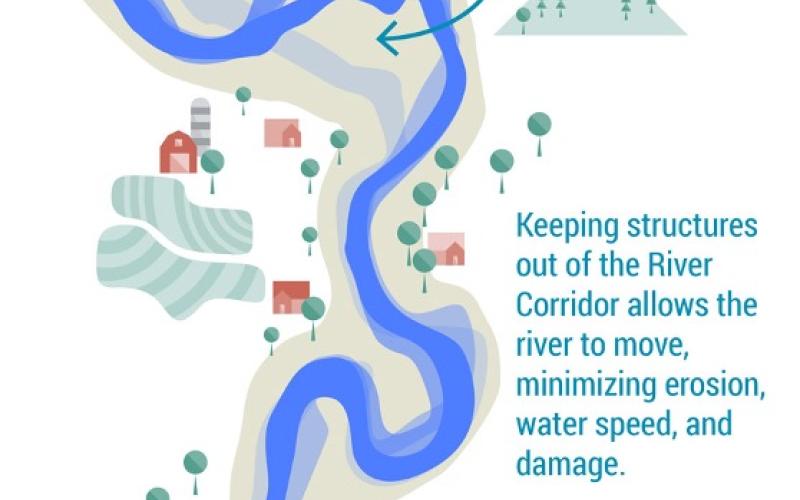
Reducing Vermont’s Exposure to Flood Hazards through River Corridor Protections
Vermont is no stranger to devastating floods. Large and disastrous storms have been recorded as far back as 1869 and nearly every year, damage from smaller, more localized floods affect communities across the state. As a result, flooding is the most common and costly recurring hazard in Vermont. In fact, a recent report from Rebuild By Design found Washington County, VT to have the highest number of federally-declared disasters in the country between 2011-2024.
Several factors contribute to the damaging effects of flooding in Vermont. The state’s mountainous landscape creates narrow river valleys where rain or snow melt funnel through. During large storms, our rivers become very powerful and can spill out into adjacent areas. Additionally, development of cities and towns have historically favored flatter areas with access to water, meaning many of the downtown areas in Vermont sit directly adjacent—or even surrounding—these rivers. Combined with more frequent heavy rainfall, our topography and development patterns have created a risky scenario for floods in the state.
Rivers need room to move
Unfortunately, previous efforts to protect our infrastructure have not reduced our risk of floods, and in many cases, have exacerbated the problem. The process of straightening, armoring, and dredging our rivers has increased their power and erosive force during large storms.
Rivers are dynamic systems that change course over time to find the slowest and least erosive path. When unobstructed, most rivers will form a curving and meandering pattern, which slows the water down and allows sediment to settle out. To better understand how rivers naturally move, the Vermont Department of Environmental Conservation (DEC) has created mapped areas called river corridors. These areas on either side of the river are where we expect the channel to adjust over time and indicates the highest risk for erosion from flooding.
When someone thinks of flooding, they most likely imagine inundation flooding, which is when rivers rise above their banks and submerge areas during large storms that do not normally have water, usually in the broader river valleys. These floodplains are crucial because they act like a pressure relief valve for the river, where the water slows down, spreads out, and becomes less destructive downstream.
However, most of the flood-related damage we see in Vermont is caused by fast waters eroding away stream banks and cutting into the land alongside the banks. Rivers naturally shift course over time to establish a meandering path so erosion like this is expected and should be planned for. Avoiding new development in both floodplains and river corridors provides more comprehensive protection, because both areas address different flood risks.
Improving flood safety in Vermont and opportunities to learn more
Damage from flooding doesn’t follow town or county boundaries and successful mitigation efforts are often the culmination of many actions taken beyond town boundaries at the larger watershed scale. Addressing flooding through a watershed-wide approach ensures all towns upstream and downstream have the same protections, making all communities safer.
In 2024, the Vermont legislature passed the Flood Safety Act (Act 121). This legislation protects river corridors statewide, strategically removes derelict dams, and increases wetland areas to store excess flood water.
In anticipation of upcoming changes at the state level regarding river corridor protections, Lake Champlain Sea Grant has partnered with The Nature Conservancy, in support of Vermont DEC, to conduct outreach to municipalities. Our aim is to help towns and community members understand the details, the timeline, and answer questions for the Flood Safety Act.
Municipal leaders or community members interested in learning more about reducing flood hazard risks can contact LCGS Flood Resilience Educator, Alison Spasyk at aspasyk [at] uvm.edu.